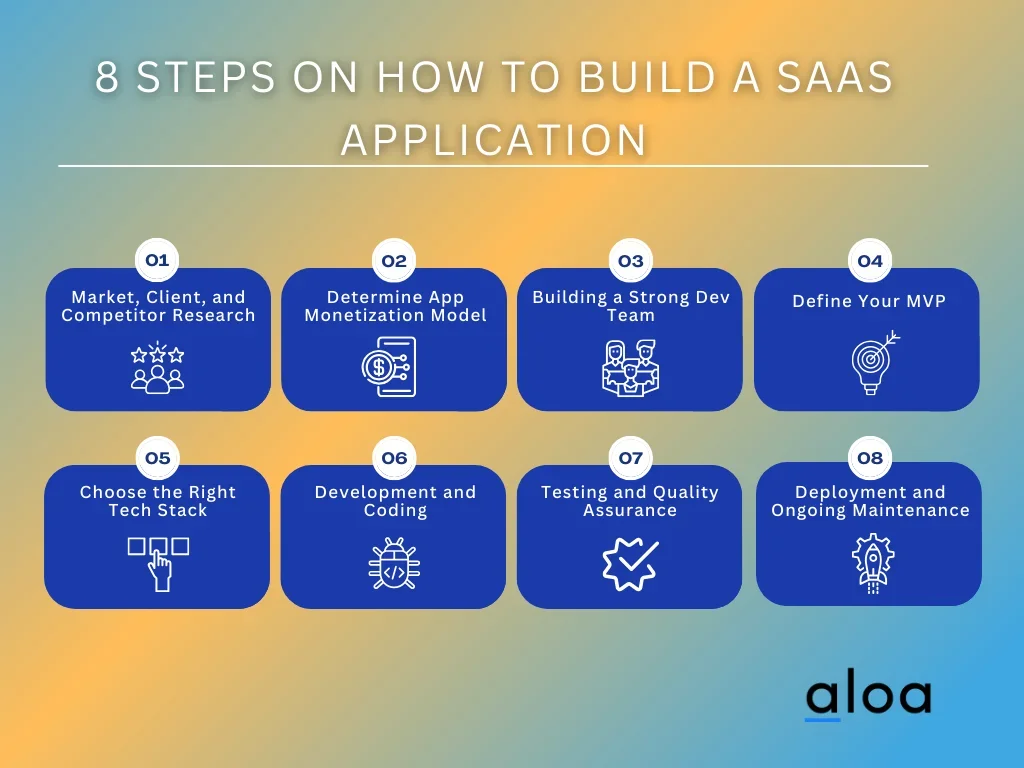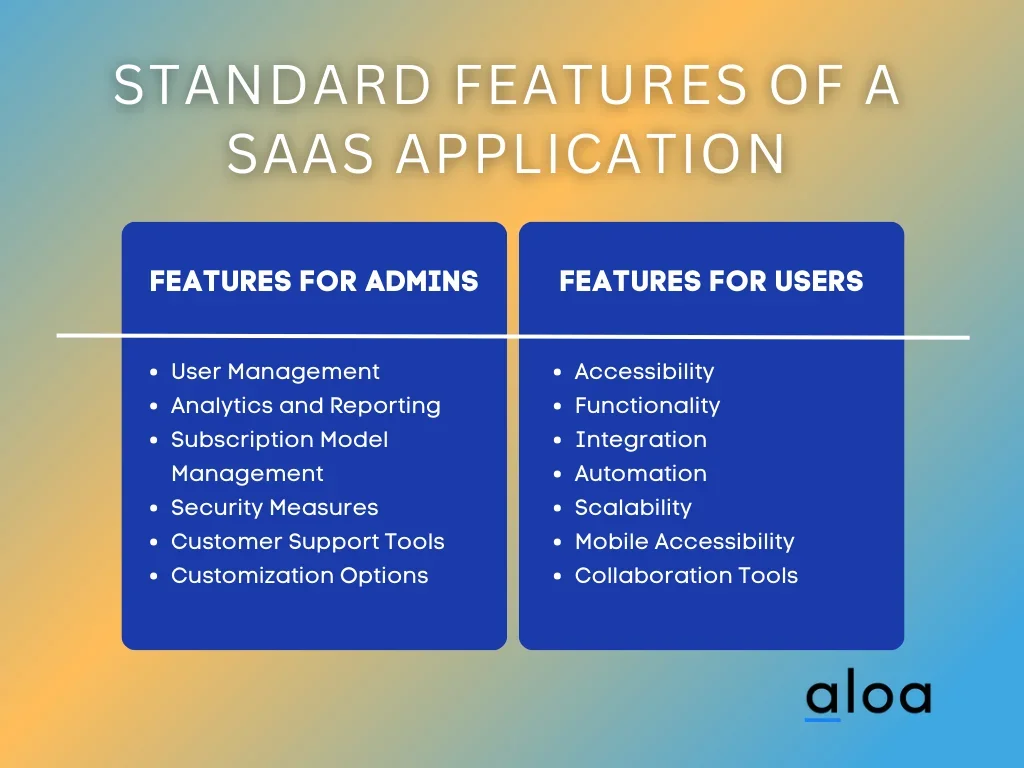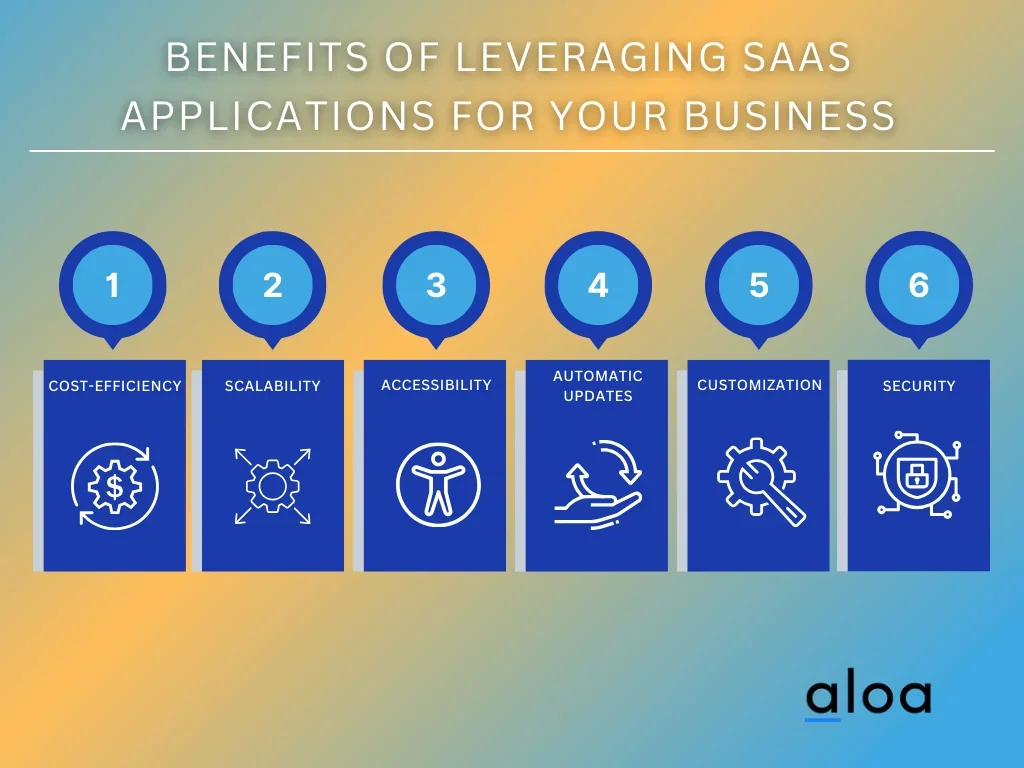SaaS applications have become essential for the survival of modern businesses. It provides a cost-effective solution to access powerful software tools through the internet. In today's digital landscape, knowing how to build a SaaS application is vital for startups and businesses aiming to stay competitive. However, creating a successful SaaS product is filled with various challenges.
Aloa, a software outsourcing expert, is readily available to steer businesses and startups through these challenges. Drawing on our extensive industry experience, we offer valuable insights and strategies for developing a tailor-made SaaS application that perfectly aligns with your unique requirements.
This blog will guide readers through the essential steps in understanding how to build a SaaS application from scratch. It covers everything from conceptualization and market research to development, testing, and deployment.
By the end of this blog, readers will have a comprehensive understanding of how to create a successful SaaS application that resonates with their target audience, scales effectively, and offers an exceptional user experience.
Whether you're a pioneering startup or an established company seeking digital transformation, our comprehensive guide will provide you with a roadmap to success on how to build a SaaS application.
Let's get started!
8 Steps on How To Build a SaaS Application
As more and more companies realize the benefits of cloud-based software solutions, the demand for SaaS applications continues to grow. This guide will walk you through the essential steps of knowing how to build a SaaS that stands out in a competitive market.

Step 1: Market, Client, and Competitor Research
Conducting thorough research is crucial before diving into the development process to ensure your SaaS idea is viable and has a market demand. Here are the critical strategies on how to build a SaaS application for conducting this research:
Market Research Strategies
- Conducting Surveys and Questionnaires: Gather insights from potential users to understand their pain points and needs.
- Analyzing Market Trends and Forecasts: Stay up-to-date with industry trends and forecasts to identify opportunities.
- Examining Industry Reports and Publications: Access existing reports and publications that provide valuable data about the SaaS market landscape.
Identifying Target Clientele
- Creating Customer Personas: Develop detailed customer personas to understand your target audience better.
- Segmentation and Targeting Strategies: Divide your audience into segments and create tailored marketing strategies.
- Defining Your Ideal Customer Profile (ICP): Determine the characteristics of your ideal customer, making it easier to target them effectively.
Competitive Analysis
- Identifying Key Competitors: Identify your main competitors in the SaaS market.
- SWOT Analysis (Strengths, Weaknesses, Opportunities, Threats): Evaluate your competitors' strengths and weaknesses to identify opportunities for differentiation.
- Differentiation Strategies: Develop strategies to set your SaaS apart from competitors.
Step 2: Determine App Monetization Model
Once you've laid the groundwork with research, the next step on how to build a SaaS is to decide on a monetization model. The chosen model will significantly impact your revenue generation. Here are the monetization strategies you can consider:
- Subscription-Based Model: This model charges users a recurring fee, typically monthly or annual, to access your SaaS application. It provides a stable income stream and encourages customer retention.
- Freemium Model: Offer a free version of your SaaS with limited features and a premium version with advanced capabilities. Users can upgrade to the premium version for a fee.
- In-App Advertising: Generate revenue by displaying advertisements within your SaaS application. This model is standard in free or low-cost SaaS offerings.
- Pay-Per-Use Model: Charge users based on their actual usage of your SaaS. This model suits SaaS apps that provide variable services like cloud computing or data storage.
Step 3: Setting up an Effective Development Team
The success of a SaaS project heavily relies on the talent and experience within the development team. It's essential to define and understand the roles and responsibilities within this team, which encompass developers, designers, project managers, and quality assurance professionals. Each role plays a crucial part in the overall development process, contributing to its success.
When making decisions about your development needs, weighing the advantages and disadvantages of hiring an in-house development team versus outsourcing is essential. In-house teams offer more control but can be costlier while outsourcing grants access to specialized expertise and potential cost savings.
Consider teaming up with a reputable development partner like Aloa. They specializes in SaaS application development and can streamline your development process, ensuring optimal quality and efficiency.
Step 4: Define Your MVP (Minimum Viable Product)
To develop a Software as a Service (SaaS) platform, beginning with a Minimum Viable Product (MVP) is crucial. The MVP represents a condensed version of your SaaS that encompasses only the essential features required to address the primary challenges faced by your intended audience.
When defining your Minimum Viable Product (MVP), it is crucial to identify the key features that align with your market research findings and customer needs. Once you have launched your MVP, prioritize actively gathering user feedback and utilizing it to enhance and expand your Software as a Service (SaaS). User feedback holds immense value in refining your product and incorporating features that truly resonate with your target audience.
Step 5: Choose the Right Tech Stack
Selecting the right technology stack is crucial for developing your SaaS application. Your choice of front-end technologies, back-end frameworks, databases, and cloud services will impact your app's performance, scalability, and user experience. Here's what to consider:
- Front-End Technologies (HTML, CSS, JavaScript): Choose the appropriate front-end technologies to create an intuitive and responsive user interface.
- Back-End Frameworks (Node.js, Ruby on Rails, Django): Select a back-end framework that aligns with your development team's expertise and your SaaS requirements.
- Database Selection (SQL vs. NoSQL): Decide between SQL and NoSQL databases based on your data storage and retrieval needs.
- Scalability and Cloud Services (AWS, Azure, Google Cloud): Ensure your SaaS can scale seamlessly by leveraging cloud services from providers like AWS, Azure, or Google Cloud.
Step 6: Development and Coding
Once you have made your technology stack selection, it is time to delve into development and coding. This critical step on how to build a SaaS app entails transforming your SaaS concept into a fully functioning application.
To ensure maintainability and collaboration within your development team, adhering to clean code principles is crucial. By writing code that is easy to understand, modular, and follows best practices, you can promote efficient teamwork. Implementing version control using Git allows you to track changes and collaborate effectively. Additionally, utilizing branching and merging strategies helps in managing the codebase efficiently.
CI/CD pipelines should be established to automate the process of testing and deployment. This ensures that the application is consistently integrated, tested, and deployed, allowing for smooth delivery of updates.
Step 7: Testing and Quality Assurance
Testing and quality assurance are crucial components in delivering a reliable SaaS application. Different types of testing fulfill specific roles, ensuring the robustness of your software.
Unit testing focuses on the examination of individual components or functions. Integration testing, on the other hand, ensures the seamless collaboration of different components. User acceptance testing involves real users actively evaluating software for its usability and functionality. Performance testing assesses various aspects like speed, responsiveness, and scalability under different conditions.
To ensure a positive user experience, it is essential to implement comprehensive testing and quality assurance practices. These measures are crucial in identifying and resolving issues before they impact your users. By undertaking thorough testing processes, you can address any potential problems promptly,
Step 8: Deployment and Ongoing Maintenance
Deployment signals the shift from development to production, enabling users to access your SaaS application. Furthermore, ensuring ongoing maintenance is crucial for maintaining smooth operation and meeting user expectations. Ensure a s\mooth deployment process by following these steps:
- Choose a reliable hosting environment, whether on-premises or in the cloud, to ensure high availability and scalability.
- Perform thorough testing in a staging environment to minimize disruptions during deployment.
- Monitor the application's performance and user feedback post-launch to address any issues promptly.
- Implement a robust maintenance plan to keep your SaaS application up-to-date, secure, and feature-rich.
Standard Features of a SaaS Application
SaaS applications provide businesses of all sizes with accessibility, scalability, and cost-efficiency. This makes them a popular choice among users. If you're wondering how to build a SaaS, grasping the standard features necessary for creating a successful one is essential.

Features for Admin
Admin features are the backbone of any SaaS application, and understanding how to build a SaaS to manage and maintain the platform efficiently needs the necessary tools. These features are crucial for overseeing user accounts, controlling data, and ensuring the platform's smooth operation.
- User Management: Effective SaaS applications allow administrators to effortlessly create, edit effortlessly, and deactivate user accounts. This ensures enhanced access control and streamlines the process of user onboarding.
- Analytics and Reporting: Robust analytics tools empower administrators to effortlessly track user activities, monitor system performance, and gain valuable insights. These analytics are crucial in informing data-driven decisions and enhancing application functionality.
- Subscription Model Management: Admins have the ability to establish and oversee a range of subscription plans, allowing users to select the one that aligns most effectively with their requirements. This flexibility plays a vital role in attracting a more comprehensive customer base.
- Security Measures: The protection of user data holds utmost importance. To safeguard sensitive information, administrators must implement rigorous security measures that encompass encryption, access controls, and regular security audits.
- Customer Support Tools: Efficient customer support is crucial in retaining customers. To ensure a seamless user experience, administrators should be equipped with customer relationship management (CRM) tools. These tools enable tracking interactions, resolving issues, and maintaining solid customer relationships.
- Customization Options: The use of customizable features in this SaaS application allows administrators to personalize it according to their business's unique requirements. This includes custom branding and adjustments to the user interface, empowering admins with complete control over tailoring the application.
Features for User
While admin features play a crucial role in managing the system in the background, it is equally essential to prioritize user-centric features—the success of knowing how to build a SaaS application relies on prioritizing user experience to meet their needs and expectations effectively.
- Accessibility: The importance of a user-friendly web browser interface for SaaS success. The application should be easily accessible from any location with an internet connection, offering users flexibility and convenience.
- Functionality: The functionality of a SaaS application should align with its respective niche. Whether it caters to project management, ERP, or CRM, users should easily find the features they require.
- Integration: SaaS applications often require integration with various software, including Microsoft Office, Adobe Suite, and backend databases like PostgreSQL or MySQL. The seamless integration of these tools boosts productivity and streamlines workflow processes.
- Automation: Implementing automation features, such as scheduled reports, email notifications, or data imports, streamlines user workflows and saves valuable time while enhancing efficiency. Users can automate routine tasks to optimize their productivity effectively.
- Scalability: SaaS applications should accommodate growth. Users should have the flexibility to upgrade their subscription or add more features as their business expands.
- Mobile Accessibility: As mobile device usage rises, having a responsive mobile interface or dedicated app becomes imperative. This guarantees that users can conveniently access the SaaS application while on the move.
- Collaboration Tools: Collaboration features like real-time document editing, chat, and project management tools promote effective team collaboration. This is particularly important for businesses that rely on remote work or teamwork.
Benefits of Leveraging SaaS Applications for Your Business
Understanding how to develop a Software as a Service (SaaS) solution can have a transformative impact. SaaS applications are highly favored by businesses due to their numerous benefits. Now, let's delve into the advantages of utilizing SaaS applications for your business.

Cost-Efficiency
Developing a traditional software solution can incur significant costs due to server maintenance and infrastructure expenses. However, understanding how to build a SaaS eliminates these financial burdens. SaaS applications are hosted on the cloud, allowing for subscription-based payments and reducing upfront expenditures.
Scalability
SaaS applications possess a remarkable ability to effortlessly accommodate your expanding user base while maintaining high scalability. This inherent flexibility ensures that your business can readily adapt to changing demands without necessitating extensive software development efforts.
Accessibility
SaaS enables users to conveniently access applications through a web browser, regardless of physical location. This accessibility fosters seamless collaboration and facilitates remote work, ultimately facilitating the expansion of businesses across borders by effortlessly connecting with a global customer base.
Automatic Updates
SaaS providers handle software updates, ensuring your application remains up-to-date and secure. This relieves your team from the constant maintenance burden, allowing them to devote their energy to essential business activities.
Customization
When developing a SaaS product, businesses can customize the application according to their unique needs. This level of customization allows for delivering exceptional value to customers.
Security
SaaS companies prioritize security, often implementing advanced encryption and authentication measures. These measures protect sensitive data, offering users and customers peace of mind.
Key Takeaway
Understanding how to build a SaaS is crucial for startups and established businesses. The process of building a SaaS application involves comprehending software development, server infrastructure, and programming languages. To ensure success, startups and businesses should consider collaborating with experienced professionals who specialize in SaaS application development. These experiences can offer valuable guidance, develop custom software tailored to specific needs, and navigate the complexities of creating a robust SaaS platform.
For more information on how to build a SaaS or to discuss your SaaS software development project, feel free to reach out to us at resource[email protected]. We possess the expertise required to help you succeed in the ever-changing realm of SaaS. Don't miss out on the opportunities this transformative business model can offer within today's digital landscape.

